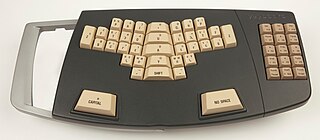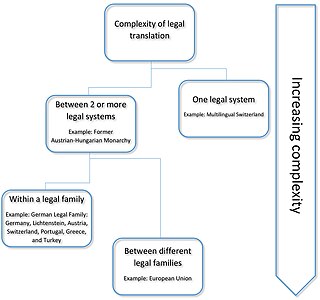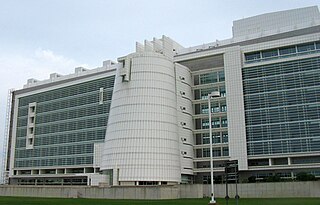Related Research Articles

Shorthand is an abbreviated symbolic writing method that increases speed and brevity of writing as compared to longhand, a more common method of writing a language. The process of writing in shorthand is called stenography, from the Greek stenos (narrow) and graphein. It has also been called brachygraphy, from Greek brachys (short), and tachygraphy, from Greek tachys, depending on whether compression or speed of writing is the goal.

Velotype is the trademark for a type of keyboard for typing text known as a syllabic chord keyboard, an invention of the Dutchmen Nico Berkelmans and Marius den Outer.

A court reporter, court stenographer, or shorthand reporter is a person whose occupation is to capture the live testimony in proceedings using a stenographic machine or a stenomask, thereby transforming the proceedings into an official certified transcript by nature of their training, certification, and usually licensure. This can include courtroom hearings and trials, depositions and discoveries, sworn statements, and more.
Communication access realtime translation (CART), also called open captioning or realtime stenography or simply realtime captioning, is the general name of the system that stenographers and others use to convert speech to text. A trained operator writes the exact words spoken using a special phonetic keyboard, or stenography methods, relaying a reliable and accurate translation that is broadcast to the recipient on a screen, laptop, or other device. CART professionals have qualifications for added expertise (speed and accuracy) as compared to court reporters and other stenographers.

A stenomask is a hand-held microphone built into a padded, sound-proof enclosure that fits over the speaker's mouth or nose and mouth. Some lightweight versions may be fitted with an elastic neck strap to hold them in place while freeing the user's hands for other tasks. The purpose of a stenomask is to allow a person to speak without being heard by other people, and to keep background noise away from the microphone.

A steno machine, stenotype machine, shorthand machine, stenograph or steno writer is a specialized chorded keyboard or typewriter used by stenographers for shorthand use. In order to pass the United States Registered Professional Reporter test, a trained court reporter or closed captioner must write speeds of approximately 180, 200, and 225 words per minute (wpm) at very high accuracy in the categories of literary, jury charge, and testimony, respectively. Some stenographers can reach 300 words per minute. The website of the California Official Court Reporters Association (COCRA) gives the official record for American English as 375 wpm.

Legal translation is the translation of language used in legal settings and for legal purposes. Legal translation may also imply that it is a specific type of translation only used in law, which is not always the case. As law is a culture-dependent subject field, legal translation is not necessarily linguistically transparent. Intransparency in translation can be avoided somewhat by use of Latin legal terminology, where possible, but in non-western languages debates are centered on the origins and precedents of specific terms, such as in the use of particular Chinese characters in Japanese legal discussions.

Gregg shorthand is a form of shorthand that was invented by John Robert Gregg in 1888. Like cursive longhand, it is completely based on elliptical figures and lines that bisect them. Gregg shorthand is the most popular form of pen stenography in the United States; its Spanish adaptation is fairly popular in Latin America. With the invention of dictation machines, shorthand machines, handheld tape recorders, digital voice recorders, voice recording apps on smartphones, and the practice of executives writing their own letters on their personal computers, the use of shorthand has gradually declined in the business and reporting world. However, Gregg shorthand is still in use today.
A transcript is a written record of spoken language. In court proceedings, a transcript is usually a record of all decisions of the judge, and the spoken arguments by the litigants' lawyers. A related term used in the United States is docket, not a full transcript. The transcript is expected to be an exact and unedited record of every spoken word, with each speaker indicated. Such a record was originally made by court stenographers who used a form of shorthand abbreviation to write as quickly as people spoke. Today, most court reporters use a specialized machine with a phonetic key system, typing a key or key combination for every sound a person utters. Many courts worldwide have now begun to use digital recording systems. The recordings are archived and are sent to court reporters or transcribers only when a transcript is requested. Many US transcripts are indexed by Deposition Source so that they may be searched by legal professionals via the Internet. Transcripts may be available publicly or to a restricted group of persons; a fee may be charged.
Medical transcription, also known as MT, is an allied health profession dealing with the process of transcribing voice-recorded medical reports that are dictated by physicians, nurses and other healthcare practitioners. Medical reports can be voice files, notes taken during a lecture, or other spoken material. These are dictated over the phone or uploaded digitally via the Internet or through smart phone apps.

Subtitles are text representing the contents of the audio in a film, television show, opera or other audiovisual media. Subtitles might provide a transcription or translation of spoken dialogue. Although naming conventions can vary, captions are subtitles that include written descriptions of other elements of the audio like music or sound effects. Captions are thus especially helpful to people who are deaf or hard-of-hearing. Subtitles may also add information that is not present in the audio. Localizing subtitles provide cultural context to viewers. For example, a subtitle could be used to explain to an audience unfamiliar with sake that it is a type of Japanese wine. Lastly, subtitles are sometimes used for humor, as in Annie Hall, where subtitles show the characters' inner thoughts, which contradict what they were saying in the audio.
Shorthand education is education in shorthand or stenography. Stenography or shorthand has been taught in stenography schools and other institutions, including public schools.

The National Court Reporters Association, or NCRA, is a US organization for the advancement of the profession of the court reporter, closed captioner, and realtime writer. The association holds annual conventions, seminars and forums, speed and real-time contests, and teachers' workshops to assist court reporters.
A speech-to-text reporter (STTR), also known as a captioner, is a person who listens to what is being said and inputs it, word for word, as properly written texts. Many captioners use tools which commonly converts verbally communicated information into written words to be composed as a text. The reproduced text can then be read by deaf or hard-of-hearing people, language learners, or people with auditory processing disabilities.

The Alfonse M. D'Amato United States Courthouse is a federal courthouse for the United States District Court for the Eastern District of New York. It is located at 100 Federal Plaza in Central Islip on Long Island in New York. It is named after former U.S. Senator Al D'Amato of New York, a native of Long Island.
The Stenographers' Guild, founded in 1937, is a non-profit organization providing vocational education and training in the area of Secretarial skills, Information Technology and Shorthand. It is located in T. Nagar, Chennai in the Indian state of Tamil Nadu.

Robertson College is a private Canadian career training institution headquartered in Winnipeg, Canada. Robertson has campus locations in Winnipeg in Manitoba and Edmonton and Calgary in Alberta. Robertson offers diploma and certificate programs.
A transcription service is a business service that converts speech into a written or electronic text document. Transcription services are often provided for business, legal, or medical purposes. The most common type of transcription is from a spoken-language source into text. Common examples are the proceedings of a court hearing such as a criminal trial or a physician's recorded voice notes. Some transcription businesses can send staff to events, speeches, or seminars, who then convert the spoken content into text. Some companies also accept recorded speech, either on cassette, CD, VHS, or as sound files. For a transcription service, various individuals and organizations have different rates and methods of pricing. Transcription companies primarily serve private law firms, local, state, and federal government agencies and courts, trade associations, meeting planners, and nonprofits.
A scopist edits the transcripts of official proceedings, created by court reporters. Court reporters attend official proceedings such as court hearings and transcribe the spoken word to written text. Court reporters take down official proceedings using voice writing or stenography. Scopists receive the rough copies of these transcripts after the proceedings, check the transcript for missing words or mistakes, edit grammar and punctuation, ensure that proper names and technical or scientific terms are spelled correctly, and format the transcript properly before delivering the transcript back to the court reporter. Unlike most careers in the legal field, scopists can be outsourced as they are not directly involved in the legal process.
Voice writing is a method used for court reporting, medical transcription, CART, and closed captioning. Using the voice writing method, a court reporter speaks directly into a stenomask or speech silencer - a hand-held mask containing one or two microphones and voice-dampening materials. As the reporter repeats the testimony into the recorder, the mask prevents the reporter from being heard during testimony.
References
- ↑ "Real-time Transcription". Transcription Jobs HQ. 2020. Retrieved 2020-04-19.
- 1 2 Downey, Greg (2006). "Constructing "Computer-Compatible" Stenographers: The Transition to Real-Time Transcription in Courtroom Reporting". Technology and Culture. 47 (1): 1–26. doi:10.1353/tech.2006.0068. ISSN 0040-165X. JSTOR 40061005.
- 1 2 "What is Court Reporting | NCRA". www.ncra.org. Retrieved 2020-04-19.
- ↑ "Court Reporter: How Do I Become a Court Reporter?". Study.com. Retrieved 2020-04-19.
- 1 2 3 Sappington, Betty Gae Hughes (1983). "Study of Court Reporter Training Programs in Texas and Oklahoma" (PDF). Oklahoma State University.
- ↑ "Certification". NCRA. Retrieved April 19, 2020.
- ↑ Bolat, Dorris, M. "Transcription services" . Retrieved 30 December 2021.
{{cite news}}: CS1 maint: multiple names: authors list (link) - ↑ Oscar Rose Junior College. "Court Reporting Questions and Answers."
- ↑ Bove, A. J. (1920). "Spanish Stenography". Hispania. 3 (5): 255–257. doi:10.2307/330898. JSTOR 330898.
- ↑ Heffner, R.-M. S. (1934). "Concerning Transcription". Language. 10 (3): 286–290. doi:10.2307/409478. JSTOR 409478.
- ↑ Ochs, Elinor (1979). Developmental Pragmatics. New York: Academic Press. p. 44. ISBN 0125245505.
- 1 2 Hennink, Monique; Weber, Mary Beth (2013). "Quality Issues of Court Reporters and Transcriptionists for Qualitative Research". Qualitative Health Research. 23 (5): 700–710. doi:10.1177/1049732313481502. ISSN 1049-7323. PMC 4465445 . PMID 23512435.
- ↑ Macaulay, Ronald K. S. (1991). ""Coz It Izny Spelt When They Say It": Displaying Dialect in Writing". American Speech. 66 (3): 282. doi:10.2307/455800. JSTOR 455800.
- ↑ Macaulay, Ronald K. S. (1991). ""Coz It Izny Spelt When They Say It": Displaying Dialect in Writing". American Speech. 66 (3): 284. doi:10.2307/455800. ISSN 0003-1283. JSTOR 455800.